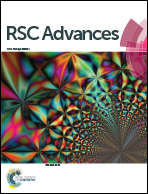Investigation of biological cell–small molecule interactions with a gold surface plasmon resonance sensor using a laser scanning confocal imaging-surface plasmon resonance system†
Abstract
In our work, we investigated the interactions between a small molecule, folic acid, and biological cells through the interaction of folic acid and folate receptors using a laser scanning confocal imaging-surface plasmon resonance (LSCI-SPR) system. The changes of SPR peaks and cell concentration had good linear relationships, and fluorescence imaging provided further data. The detection limit was as low as 1.0 × 103 cells per mL, and linear coefficients were 0.95206, 0.95454, 0.94287, 0.98711, and 0.99228 for mouse lymphoma (L5178Y TK+/−) cells, mouse lymphoma (EL4) cells, mouse T lymphocytes (Cl.Ly 1+2−/9) cells, human lung cancer (A549) cells, and human oral epidermis carcinoma (KB) cells, respectively. The results indicated that the LSCI-SPR system has potential future application in analyzing small molecule–biological cell affinity and in acquiring quantitative parameters.


 Please wait while we load your content...
Please wait while we load your content...